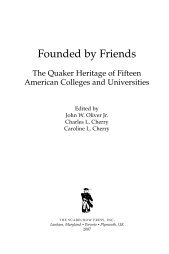Separate Realities: The Dream and the Iceberg - Scarecrow Press
Separate Realities: The Dream and the Iceberg - Scarecrow Press
Separate Realities: The Dream and the Iceberg - Scarecrow Press
Create successful ePaper yourself
Turn your PDF publications into a flip-book with our unique Google optimized e-Paper software.
56 Chapter 2<br />
with children, occurred primarily because wives sharply increased <strong>the</strong>ir annual<br />
hours of work. For example, wives between <strong>the</strong> ages of twenty-five <strong>and</strong> fifty-four<br />
with children in <strong>the</strong> middle-income quintile increased <strong>the</strong>ir annual hours of<br />
paid employment from 849 in 1979 to 1,327 in 2004. 51<br />
<strong>The</strong> evidence concerning income trends supports <strong>the</strong> conclusion that <strong>the</strong>re<br />
has been a growing polarization of income in <strong>the</strong> United States. Using Census<br />
Bureau information, <strong>the</strong> Economic Policy Institute (EPI) provides a useful way<br />
of illustrating <strong>the</strong> extent of inequality concerning income redistribution in <strong>the</strong><br />
United States. <strong>The</strong> EPI reports <strong>the</strong> shares of aggregate (total) national income<br />
received by U.S. families divided into five quintile groups, arrayed by income<br />
levels from <strong>the</strong> lowest 20 percent to <strong>the</strong> highest 20 percent (all amounts in<br />
2004 dollars).<br />
Drawing upon EPI <strong>and</strong> Census Bureau data, figure 2.1 summarizes several<br />
aspects of family income levels <strong>and</strong> redistribution trends in recent years. First,<br />
it illustrates, using side-by-side comparisons, <strong>the</strong> shares of national income received<br />
by families in each quintile group for 1974 <strong>and</strong> 2004. Second, <strong>the</strong> first<br />
line at <strong>the</strong> bottom of <strong>the</strong> figure reports <strong>the</strong> percentage changes in family income<br />
shares from 1974 to 2004 for each quintile group. Finally, <strong>the</strong> last line<br />
at <strong>the</strong> bottom of <strong>the</strong> figure provides a summary of 2004 family income ranges<br />
for each quintile. 52<br />
During <strong>the</strong> 1974–2004 period, each quintile group experienced changes in<br />
<strong>the</strong> percentage of aggregate income received, ranging from highly positive to<br />
highly negative. <strong>The</strong> top 20 percent experienced an 18 percent increase in its<br />
share of national income (from 40.6 percent in 1974 to 47.9 percent in 2004),<br />
whereas <strong>the</strong> o<strong>the</strong>r four quintiles all experienced decreases in <strong>the</strong>ir shares of national<br />
income. <strong>The</strong>se ranged from a modest loss of 3 percent for <strong>the</strong> fourth<br />
quintile (dropping from 24.1 percent to 23.0 percent) to a whopping 26 percent<br />
loss for <strong>the</strong> bottom quintile (dropping from 5.7 to 4.0 percent). <strong>The</strong><br />
changes in income shares for <strong>the</strong>se five groups reflect <strong>the</strong> reality that income<br />
was redistributed over <strong>the</strong> 1974–2004 period in an upward direction.<br />
<strong>The</strong> income ranges reported as <strong>the</strong> last line of figure 2.1 provide a context<br />
for considering <strong>the</strong> impact of upward income redistribution. <strong>The</strong> income<br />
range for <strong>the</strong> bottom quintile in 2004 included all families with incomes up<br />
to $24,780 (in 2004 dollars). This means not only that families in this group<br />
have <strong>the</strong> lowest incomes, but also that <strong>the</strong>y will be most affected by income<br />
losses because <strong>the</strong>y have <strong>the</strong> fewest resources to begin with. Yet this group suffered<br />
<strong>the</strong> greatest loss in income share during <strong>the</strong> 1974–2004 period. <strong>The</strong> income<br />
ranges for <strong>the</strong> second quintile ($24,781 to $43,400), <strong>the</strong> middle quintile<br />
($43,401 to $65,832), <strong>and</strong> <strong>the</strong> fourth quintile ($65,833 to $100,000)<br />
provided <strong>the</strong>se groups with greater cushions (compared with <strong>the</strong> bottom<br />
quintile) to absorb income losses. Of course, <strong>the</strong> top quintile, with an income<br />
range of $100,001 <strong>and</strong> up, needed no cushion; it increased its income share<br />
by 18 percent.
















